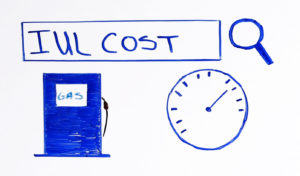You may have found articles on the Internet stating that an Indexed Universal Life (IUL) policy is expensive, but is that really the truth? In this episode of Money Script Monday, Brian breaks down the types of cost associated with an IUL policy and compares it to other financial vehicles you may be considering.
<script src=”https://fast.wistia.com/embed/medias/z2oij6cs8s.jsonp” async></script><script src=”https://fast.wistia.com/assets/external/E-v1.js” async></script><div style=”padding:56.25% 0 0 0;position:relative;”><div style=”height:100%;left:0;position:absolute;top:0;width:100%;”><div style=”height:100%;width:100%”> </div></div></div>
Video transcription
Hello. Welcome to another episode of Money Script Monday. My name is Brian Manderscheid. Today, we’re going to talk about the cost associated with an Indexed Universal Life (IUL) policy.
Searching online for IUL Costs
If you do an internet search on IUL cost, you may find some articles, likely biased articles from people trying to sell you other vehicles, whether those are Mutual Funds or maybe even a Whole Life policy, about the number one reason why not to buy an IUL, which are the policy costs. My goal here today is to describe to you what the policy costs are in an IUL, talk about some alternatives that you’re maybe considering, as well as giving enough information to determine if an IUL policy is right for you.
More…
Now, when you go to make another important financial decision, not a financial vehicle but an automobile, it’s typically easy to look at different product features and benefits, whether it’s miles per gallon with a fuel efficiency or whether it’s the size of the engine with performance. It’s typically easy whether online or going to the dealership, lifting up the hood, going for a test drive, to compare different vehicles side by side.
With financial vehicles, it’s often difficult to get a financial advisor to disclose and describe the fees associated with the vehicle that you’re describing, as well as to look at some possible alternative options in how they stack up.
Types of costs
There are two types of IUL policy costs. These are going to differ from company to company and the fees will be fully disclosed upfront and transparent.
The two types of costs you’ll see with inside an IUL are:
(1) Fixed Expenses
These are based on the policy you are going to buy and are not going to change.
- Premium Load – This is deducted right from the top of the premium you pay into your IUL policy, and it’s going to go to any state premium taxes, if applicable, and also to the insurance company profitability.
- Administration Fee – This is typically a nominal amount that will exist for the life of the contract.
(2) Variable Expenses
These are based on your age, gender, and health, as well as a death benefit amount that you purchase.
It’s very important to note that when you’re building an IUL policy, for cash value growth and tax-free income, we always want to buy the least amount of death benefit that the IRS will allow, and fund it right up to the maximum guidelines. This will ensure that we can minimize these variable expenses, so that a majority of your premium goes to cash value growth, and less of it goes to policy expenses.
- Expense Charge – This typically lasts for ten years and is front-loaded in the contract. These go to the acquisition costs that the insurance company has, whether that’s all the medicals that they have to order, getting doctors’ records, and even paying a commission to the agent.
- Mortality Charges – These are the pure mortality cost, which are used to basically cover the death benefit for your family, your business, or maybe even your favorite charity.
- Surrender Charges – This only apply if you were to walk away from your contract. In the surrender charge period, you may have a cost associated with that. It’s typically ten-year schedule, being a declining schedule, meaning that they’ll be higher in the initial years and lower in the last years. We know that life happens, and potentially, you could surrender a policy. That’s obviously not our intent, and we would like to obviously have this policy for life.
Comparison of fees
We talked about the types of policy fees that are associated with an IUL. Let’s now look at a comparison of what those fees may look like.
- In green, you’ll see the IUL policy costs.
- In blue, you’ll see a hypothetical alternative with a 1% expense and no taxes.
- In red, you’ll see a hypothetical alternative with 1% fee and 25% in taxes.
It’s important to note that your tax rate may be higher or lower and that these numbers will differ based on your exact tax rate. Also, in this example, we’re assuming that the vehicle is taxed as earned on each of the year’s annual gains.
A couple of things to point out. You can see upfront right away, the IUL costs are higher than the alternatives. However, over the long run, you can see the IUL costs are actually lower than the other alternative options. You’ll also see some crossover points in the latter years where the cumulative expenses at 1% of the alternative with no taxes, actually becomes more costly than the IUL.
Likewise, you’ll see that in the same scenario with the 1% fee and taxes scenario, obviously, it happens much sooner when you have both fees and taxes associated with the alternative.
Obviously, the fact that with the IUL the policy costs are front-loaded, likely when you need the money in the policy the least, whereas they are lowest when you’re likely to need the money the most.
And the alternatives with fees and taxes, you can see that they start off lower when your account value is small, but once your account value starts to rise and over the years, the fees that you’re paying and the taxes will actually exponentially increase, so that the fees and taxes you’re paying are likely to be highest, actually, when you need the money the most.
40 year cost example
Let’s look at an actual example of a 45-year-old male in good health. Now, keep in mind that you may be a female, or you may be older or younger than this individual, or in better or worse health. These numbers, basically, just are hypothetical scenario of what they will look like, what the fees would look like, as well as what they stack up against all in the alternatives.
What I did here was I looked at the annual policy fees as a percentage of our account value. For example, if we had $1,000 in charges with a $100,000 account value, our fees would be 1% of our account.
In looking at the IUL, the first policy year, the worst year that we’ll find, the total fees as a percent of our account value is actually almost 10%. I would say that’s definitely high in the first year, and if you’re looking for a good first-year return or short-term investment, the IUL is definitely not what you’d want to consider. However, in the tenth year, we’re about 1.5%, which I would say is still a little high, but if you compare those two alternatives that you maybe consider, let’s say you’re investing and actively managed Mutual Funds and paying an advisory fee, you may likely be at 1% or 1.5%, if not higher.
Now, in the 20th year, we’re at 75 basis points, 3 quarters of a percent, and now we’re starting to get to the point where the fees are actually lower than many of the alternatives that you may be considering.
And then in the 30th year, the fees are actually 13 basis points. That’s 0.13%. Now we’re getting very cost efficient. All we have at that point are the policy administration charges and some small amount of costs of insurance, and we’re very cost efficient at that point.
In the 40th year, the average over the 40-year time frame is 1.04%. So for this 45-year-old-male, over his lifetime, he’s paying about 1% in fees. And it’s important to mention that a majority of those fees went for a death benefit, for his family, maybe his business, or maybe even his favorite charity. Now, when you compare those to the same alternatives at 1% fee, no taxes, and a 1% fee and 25% taxes, obviously, the fees at the 1% are the same at 1 each and every year in the average.
Now, when we look at the fees and taxes scenario, again, keep in mind that if you’re in a higher than 25% tax bracket, these numbers will actually be much higher than shown here. In the first year, the fees at 1% plus taxes at 25% were actually 2.4%. Again, pretty expensive, but actually, it gets worse with the larger your account value grows to, the more fees and taxes you’ll be paying.
In the 10th year right about 6.5%. The 20th year, 10.5%. And then the 30th year, we’re actually over 16% with the taxes and fees you’ll be paying in this alternative. Over 40 years, you can see the average expense as a percentage of our account value is over 11%. So you can see that if you are paying fees on your investments, and paying taxes on those gains, the fees are actually extremely high over the years.
Now, to sum up what we talked about today, we talked about how, again, not everything you read on the internet is true. And it’s important to work with a qualified financial advisor, who’s going to accurately describe and disclose to you what the fees are and how those may stack up next to alternatives. We talked about what the types of policy costs are, both fixed and variable.
And lastly, we talked about the policy costs themselves, how they stack up to alternatives. We determined that the IUL actually has higher costs upfront because of the front-loaded nature. In the long run, they’re actually very efficient and at par if not lower than alternatives that you’re considering.

